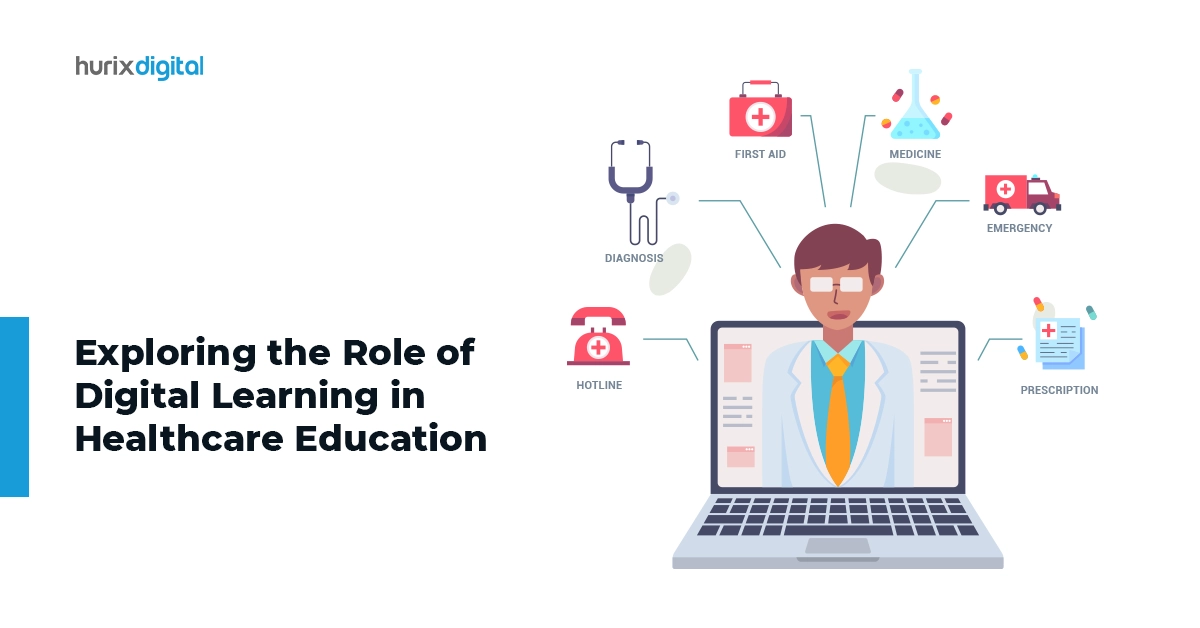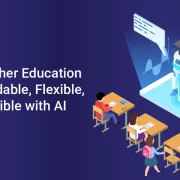
Exploring the Role of Digital Learning in Healthcare Education
Summary
Investigate how digital learning technologies are being used in healthcare education to improve training, patient care, and professional development.
Medical education is at a crossroads. Traditional methods face limitations, leaving students hungry for deeper engagement and practical experience. Training fuels every profession, but for healthcare, it is a lifeline.
Online learning empowers individuals to absorb knowledge at their own pace and through their preferred styles. Coupled with the ability to reach a broad audience, this flexibility lays the foundation for a projected US $465.47 billion eLearning market by 2028, poised to revolutionize healthcare education.
The footsteps of digital learning in healthcare education are revolutionary, replacing static textbooks with dynamic, interactive experiences. Educators now weave multimedia, simulations, and gamification in healthcare education, bringing complex concepts to life and boosting student engagement and practical skills.
Healthcare professionals benefit from location-independent learning, accessing materials, and staying updated anytime, anywhere. E-learning platforms also foster improved communication and collaboration, enabling practitioners to share information and collectively tackle complex cases.
The benefits of eLearning for healthcare professionals ripple outward. They stay up-to-date with the latest advancements, leading to better patient care. Digital education content providers empower institutions to optimize resources and reach more learners through cost-effective and scalable solutions.
Table of Contents:
- Revolutionary Impact of Digital Learning in Healthcare Education
- How Digital Learning Helps Provide Top-Tier Healthcare Facilities?
- The Bottom Line
Revolutionary Impact of Digital Learning in Healthcare Education
Digital learning in healthcare is reshaping patient care by nurturing a more knowledgeable, skilled, and connected workforce.
1. Personalized Learning and Active Engagement
Digital learning in healthcare excels at simplifying complex concepts through textual and graphic aids. It facilitates clear connections between intricate medical information and readily understood base principles. A World Health Organization report reinforces this, asserting eLearning’s effectiveness is on par with or even exceeds traditional methods.
Interactive digital platforms offer a dynamic and personalized approach, replacing passive learning with active engagement.
Virtual anatomy programs, for instance, grant 3D explorations of the human body, surpassing the limitations of cadaver dissection. This benefit shines particularly in subjects like anatomy or physiology, where rich visual elements are vital to understanding complex concepts.
Digital education content providers embrace this need by incorporating captivating visuals that transform learning into an engaging and enlightening experience.
2. Gamification and Simulation for Immersive Learning
Technology redefines medical training, not only through knowledge delivery but also through immersive simulations and engaging eLearning.
Rehearsal for Reality
These immersive experiences, powered by AI and VR, replicate real-world clinical scenarios with stunning accuracy. Simulation-based training programs leverage mannequins and VR systems, creating safe and controlled environments for students and professionals to practice crucial procedures.
Gamified learning platforms
Educational games transform medical concepts into engaging challenges, boosting motivation and knowledge retention. Interactive quizzes, simulations with branching narratives, and collaborative tasks reward curiosity and critical thinking, turning learning into a captivating adventure.
The benefits are:
- Sharper Skills: Virtual patient simulations provide hands-on experience, translating theoretical knowledge into practical expertise. Students develop dexterity, confidence, and better decision-making under pressure, preparing them for real-world challenges.
- Reduced Errors: In simulated environments, mistakes are made and lessons are learned without jeopardizing patient safety.
- Engaged Minds: Gamification in healthcare education fuels motivation and breaks down complex concepts into digestible chunks. Students actively participate, learn faster, and retain information more effectively.
3. Flexible and Accessible solutions
Traditional training often clashes with the demanding schedules of healthcare workers. E-learning in healthcare breaks free from these constraints, offering unyielding accessibility that empowers medical professionals to learn anytime, anywhere, on any device.
- Life-saving knowledge, always within reach: Busy schedules with long shifts and on-call duties often impede healthcare professionals’ access to traditional training. eLearning for healthcare professionals provides instant access to critical training materials, ensuring essential skills and updates are just a click away—even during on-call shifts or late-night study sessions.
- Accessibility transcends location: Geographical barriers melt away with online platforms. Rural healthcare workers, international students, and even those on remote assignments can tap into a world of medical knowledge, democratizing access to quality education.
4. Collaborative Learning and Innovation
Collaboration and networking, fueled by technology, hold the key to a future of healthcare education where knowledge flows freely, innovation flourishes, and professionals from all corners of the globe unite to shape a healthier tomorrow.
Interactive forums and communities
eLearning for healthcare professionals fosters the exchange of ideas, questions, and experiences. Students discuss complex cases, educators share best practices, and professionals collaborate on research, building a bridge of knowledge accessible to all.
Social media as a learning catalyst
The rise of professional social media platforms empowers healthcare professionals to engage in real-time discussions, share cutting-edge advancements, and network with peers across the globe.
The benefits are:
- Collaboration promotes the cross-pollination of ideas, challenging assumptions, and enriching perspectives. By learning from diverse voices and experiences, individuals gain a more nuanced understanding of complex medical issues.
- Collaborative platforms ignite the sparks of collective innovation. Healthcare professionals from varied backgrounds can team up, leveraging their unique expertise to tackle pressing medical challenges and develop novel solutions with far-reaching impact.
- Online communities foster a culture of mentorship where seasoned professionals can guide and support aspiring learners. This virtual space offers unparalleled access to expertise, accelerating professional development and promoting a stronger, more connected healthcare workforce.
Also Read: Innovative Teaching: A Guide to Integrating AI-Powered Learning Tools in the Classroom
How Digital Learning Helps Provide Top-Tier Healthcare Facilities?
Advancements in digital learning in healthcare unlock the doors to transformative research and innovation, ushering in a new era of personalized medicine, AI-powered breakthroughs, and data-driven discoveries.
1. Data-driven Insights
Sophisticated tools analyze vast datasets, revealing hidden patterns and correlations unseen before. It enables researchers to delve into genomics, uncovering the secrets of genetic predisposition and paving the way for personalized medicine.
2. Personalized Medicine for Targeted Treatments
Technology becomes the architect of bespoke healthcare by enabling the analysis of individual genetic profiles and treatment responses. It allows for the development of targeted therapies and preventative measures, ushering in a new era of personalized medicine.
3. Diagnosing, Predicting, and Designing Solutions for a Healthier Tomorrow
Powerful artificial intelligence algorithms process complex medical data, assisting in diagnoses, predicting disease outbreaks, and even designing innovative drug therapies. This human-AI collaboration promises to accelerate research and propel medical advancements at an unprecedented pace.
The benefits are:
- Faster Discovery to Treatment: Technological advancements in healthcare shorten the timeline from discovery to application, bringing life-saving innovations to patients.
- Precise and Preventive Healthcare: Personalized medicine leads to more effective treatments with fewer side effects, while AI-powered disease prediction paves the way for preventative measures and improved patient outcomes.
- Empowered Future Healthcare Professionals: Medical students graduate equipped with the skills and tools to navigate the ever-evolving landscape of medical research and innovation.
Do not miss out on this EXCLUSIVE Case Study: Hurix Creates Online Programs for Nursing & Allied Health Services on a Cloud Platform
The Bottom Line
The walls of physical classrooms have fallen, replaced by a boundless, virtual learning landscape. As digital learning continues to weave its transformative threads through healthcare, the picture that emerges is one of unparalleled potential.
By integrating digital tools into training programs, we can empower our staff, equipping them with the skills and knowledge needed to navigate the ever-evolving complexities of modern medicine.
Hurix Digital stands among the foremost digital education content providers offering customized learning modules tailored to your training objectives and ensuring targeted improvement for your staff. We collaborate closely with you, prioritizing your specific requirements, budget constraints, and timelines to guarantee on-demand success.

Senior Vice President – Business Development
Over 25 years of experience in the edtech and workforce learning industry with strong skills in Business Development, Customer Relationship Management (CRM) and Strategy.



